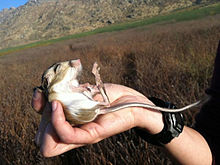Dipodomys deserti
| Desert kangaroo rat | |
|---|---|
 |
|
| Scientific classification | |
| Kingdom: | Animalia |
| Phylum: | Chordata |
| Class: | Mammalia |
| Order: | Rodentia |
| Family: | Heteromyidae |
| Genus: | Dipodomys |
| Species: | D. deserti |
| Binomial name | |
|
Dipodomys deserti Stephens, 1887 |
|
The desert kangaroo rat (Dipodomys deserti) is a rodent species in the family Heteromyidae that is found in desert areas of southwestern North America. It is one of the large kangaroo rats, with a total length greater than 12 inches (30 cm) and a mass greater than 3.2oz (91g).
The desert kangaroo rat is found in arid parts of southwestern North America, including Death Valley, the Great Basin, the Mojave Desert, and portions of the Sonoran Desert. Though kangaroo rats persist in a variety of soils, desert kangaroo rats live exclusively in areas with loose sand, often dune terrain. The places on this list constitute some of the most extreme deserts in the United States including Death Valley, which has the record for the hottest place on the continent.
Desert kangaroo rats are denizens of desert areas with sandy soil; vegetation is typically sparse and consists of creosote bush, a variety of grasses, and cacti. Desert kangaroo rats live in burrow systems under slight mounds of soil 6-9m across; they sleep in a den, which is sealed off at extreme temperatures, during the day. Groups of 6-12 widely spaced burrows may constitute a colony of this species, which is otherwise solitary.
Seeds are the dominant component of the diet of desert kangaroo rats. The size of the seeds consumed by the species tends to be larger than seeds consumed by other, sympatric heteromyids. When presented with patches with variation in seed sizes and densities—which in combination vary total profitability—desert kangaroo rats tend to choose large-seed patches but reduce profitability of a set of patches to similar levels. Seed selection also appears correlated with nutritional content, with this species choosing seeds with high carbohydrate content. Although some kangaroo rats will consume green vegetation, desert kangaroo rats do not. Feeding occurs in fits and starts of movement and at relatively discrete locations, with an average distance of ~7 m (22 ft.) between stops.
...
Wikipedia

